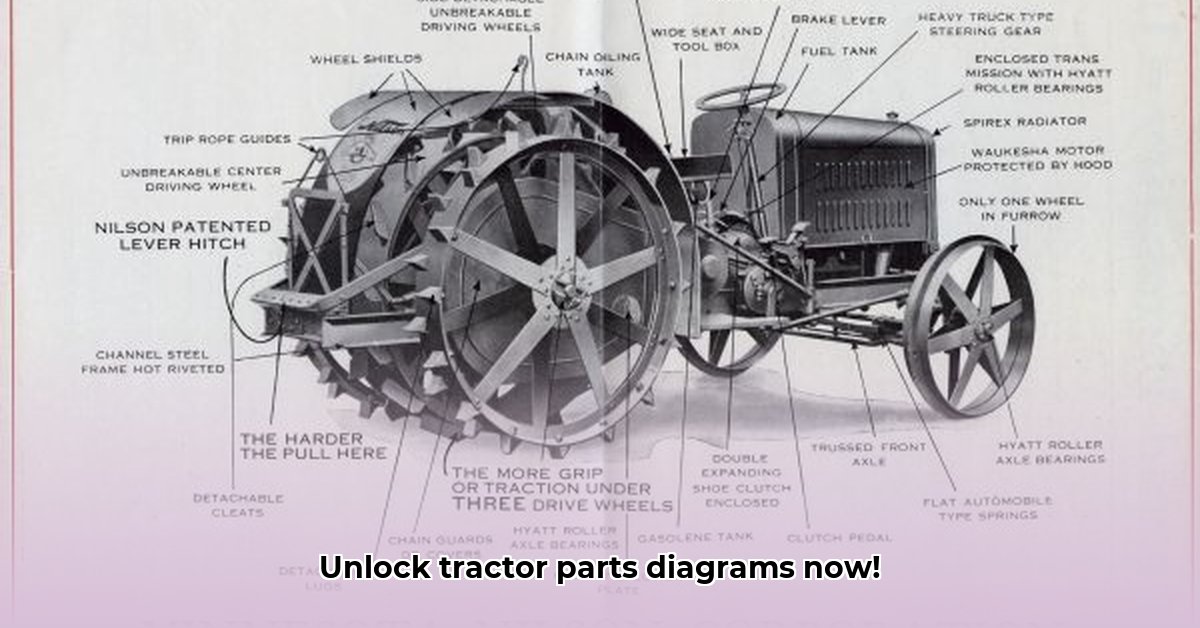
Tractor Diagram Parts: Your Guide to Finding Reliable Resources
Finding the right tractor parts can be frustrating and costly. Downtime translates to lost income, so identifying trustworthy sources for accurate parts information is critical. While the manufacturer's website is a natural starting point, its occasional unavailability highlights a crucial need for alternative, reliable resources. This article analyzes various options, helping you navigate the landscape of tractor parts information and avoid common pitfalls. For a wider selection of attachments, check out this helpful resource.
Navigating the World of Tractor Parts Information
Securing the correct information for tractor parts isn't always straightforward. Even major manufacturers experience website issues, demonstrating the risk of relying solely on one source. This dependence creates a vulnerability; what happens when your primary resource is offline? Third-party suppliers offer a solution, but how do you identify trustworthy providers?
Weighing Your Choices: Official vs. Third-Party Parts Suppliers
This comparison table highlights the key differences between official manufacturer websites (e.g., John Deere) and third-party suppliers (various online retailers specializing in agricultural parts):
| Feature | Official Manufacturer's Website | Third-Party Suppliers |
|---|---|---|
| Accuracy of Information | Generally very accurate | Accuracy varies; verification needed |
| Completeness of Information | Usually comprehensive | May have gaps; comprehensive checks needed |
| Ease of Use | Varies; some are user-friendly | Varies; user-friendliness is crucial |
| Cost | Typically higher | Often lower prices |
| Availability | Prone to occasional downtime | Usually more consistently available |
Think of it this way: the manufacturer's website is like the original blueprint—precise but potentially inaccessible. Third-party suppliers are like revised blueprints—some excellent, others flawed. Careful evaluation is key. Isn't it crucial to have multiple, reliable sources to avoid costly delays?
How to Find Accurate Tractor Diagram Parts Information
Follow these steps to minimize errors:
Cross-Reference Information: Verify information from multiple sources. Multiple confirmations increase accuracy.
Double-Check Part Numbers: Always confirm part numbers before ordering to avoid costly mistakes. This simple step saves considerable time and money.
Read Reviews: Check online reviews from other farmers before using a third-party supplier. User experiences offer insights into a supplier's reliability and customer service; isn't their feedback invaluable?
Know the Return Policy: Understand the return policy before purchasing, providing a safety net in case of errors or defects. Protecting your investment is paramount.
Protecting Yourself from Potential Problems
Imagine an urgent need for a part when the manufacturer’s website is down. Diversifying your sources is essential. This strategy mitigates frustration and productivity loss. Isn’t proactive planning your best defense against downtime?
Looking Ahead: Building a More Reliable Parts System
The occasional unavailability of major manufacturer websites underscores the need for system-wide improvement. Manufacturers and third-party suppliers must collaborate on more robust online systems, precise data, and user-friendly interfaces. Farmer feedback is also vital in this process. A reliable parts system benefits all stakeholders. The future of tractor parts sourcing will likely involve more online resources and improved integration between manufacturers and third-party suppliers. Continuous improvement of information systems and supply chains is vital for efficient agriculture.
Remember, proactive planning and utilizing multiple resources significantly reduce the risk of delays and expenses. Don't wait for a crisis; knowledge-based planning is your best protection.
How to Verify John Deere Parts Accuracy from Third-Party Suppliers
Verifying the authenticity of John Deere parts purchased from third-party suppliers is critical. This section details methods to ensure you’re receiving genuine parts and not counterfeits.
Understanding John Deere Parts Diagrams
John Deere provides comprehensive equipment diagrams—essentially roadmaps for your tractor. These numbered diagrams allow for precise part identification. Access to these diagrams (usually through the official John Deere website or authorized dealers) is crucial for accurate part selection.
How to Verify John Deere Parts Accuracy from Third-Party Suppliers
Several methods exist for authenticating parts from third-party vendors:
Cross-Reference Part Numbers: Match the third-party part number with official John Deere listings. Discrepancies indicate potential problems.
Inspect Packaging and Labeling: Authentic parts usually have high-quality packaging with clear, correct labeling and the official John Deere logo. Any inconsistencies raise concerns.
Examine the Part Itself: Check for branding, material quality, and precision. Compare to images from the John Deere diagram if possible.
Supplier Reputation: Research the supplier and check online reviews. A reputable supplier will be transparent about sourcing.
Sourcing Reliable Third-Party Suppliers
Reliable suppliers are critical:
- Check Their Online Presence: A professional website builds trust.
- Look for Certifications: Certifications demonstrate commitment to quality standards.
- Ask About Return Policies: Good suppliers offer suitable return policies.
- Read Reviews: Customer reviews highlight reliability.
- Compare Prices Carefully: Don't compromise quality for low prices.
Key Takeaways:
- Always cross-reference part numbers with official John Deere documentation.
- Carefully inspect packaging and labeling.
- Thoroughly research any third-party supplier.
- Consider the supplier's reputation and online reviews.
- Quality matters; don't always chase the lowest price.
- Regularly check the John Deere website for updates.